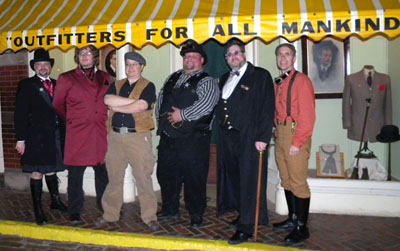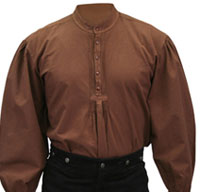In the steampunk world, I am Lucretia Strange, the Baroness Strange. I run the Promethean Society, and do a variety of presentations at steampunk conventions.
In the real world, I am Cassie Beyer and a historian with a blog, History, Interrupted, devoted to history, steampunk, costuming, popular culture and other eclectic interests.
You can best reach me through the Promethean Society or through Cassie@AlterEgoDesign.net. AlterEgo is my freelance web design endeavor focused on small businesses, individuals and organizations.
Costume Basics for Men

Shirt, pants, and shoes are the base of male attire. While women's fashion changes remarkably through the years, men's fashion has been comparatively consistent for the last couple centuries. Your closet probably already contains usable clothing. A visit to the thrift store will readily produce even more usable items.
Shirts

Workshirt with buttons half-way down gives a practical, utilitarian look.
Shirts generally have buttons running either fully or half fully down the front, and they sport a variety of collars. The standard pointed collar shirt is perfectly acceptable and in wide use. Alternative collars help to encourage a more historical look, and some work better with different kinds of ties.
Read more: Collaring Your Man and The Ties that Bind.
A variety of colors are appropriate. Historically speaking, formal, high-class occasions demanded white. Beige is popular in explorer and working-class outfits to convey a sense of practicality and hands-on experience.
Read more: Color Me Steampunk.
Pants
Dark colored dress pants are standard for any formal or high-class look. Lower-class costumes might use khakis or cargo pants.
Jeans are a basic no-no for steampunk, unless perhaps you are creating something from the Weird West, although even there they are only appropriate for the extremely low-class.
Shoes
Dress shoes work well for any higher-class outfit. They even work reasonably well in a lower-class ensemble, particularly if they're visibly worn from use. Otherwise, boots are a highly popular alternative, whether work boots or more fashionable boots.
Tennis shoes and sandals are basic no-nos.
Basic Accessories
Suspenders - Using a belt to hold up one's trousers is only
about 100 years old. Thus, every Victorian man wore suspenders. Some pants have buttons on the inside or
outside of the waistband to which suspender loops are attached, but the easier
answer is suspenders that clip to the waistband.
Vest - In England, they were known as waistcoats (pronounced wes-kits). Every Victorian middle- and upper-class man wore them, plus many of the working class. The drawback for steampunks is that they are sometimes hard to find unless you're willing to go to a steampunk or re-enactor's shop.
Coat/Jacket - Like vests, jackets were widely used on an everyday basis. These items come in a wide variety of different styles. They can be short or long, with or without tails, with or without decorated cuffs, made from a variety of fabrics, and decorated with an assortment of accoutrements. The choice of coat or jacket is determined very much by the appearance one is attempting to portray, and some steampunks forgo them entirely.
Hat - Hats are found widely in steampunk, as it was customary for just about everyone to wear a hat while outside.
Read more: Accessories for Men and Women
 Variations
Variations
Kilt instead of Pants - A traditional kilt (a long, unsewn
length of fabric pleated around the body, held in place with a belt, with the
extra thrown over the shoulder, such as what you see in Braveheart) is generally not used, due to its inconvenience
in day-to-day activities. Instead, UtiliKilts are popular with steampunks, which is a
sewn, pleated garment of durable material with many hidden pockets. More
traditional looking waist kilts are also used.
Credit
Workshirt image (c) The Gentleman's Emporium, used with permission.